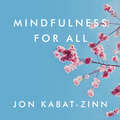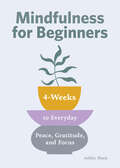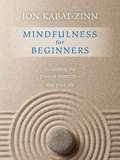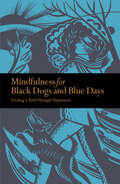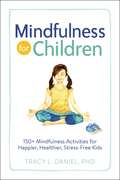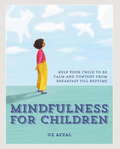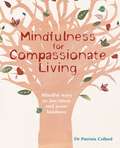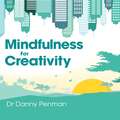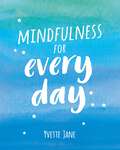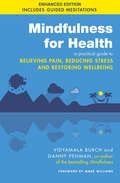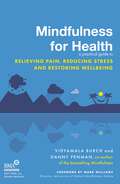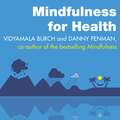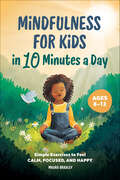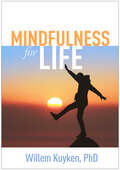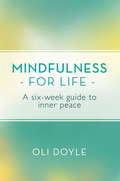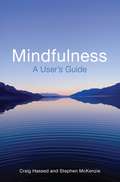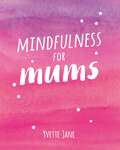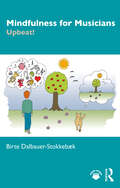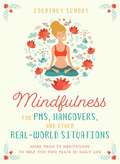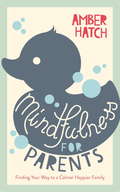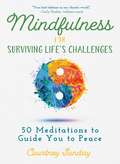- Table View
- List View
Mindfulness for All: The Wisdom to Transform the World
by Jon Kabat-ZinnMore than twenty years ago, Jon Kabat-Zinn changed the way we thought about awareness in everyday life with his now-classic introduction to mindfulness, Wherever You Go, There You Are. He followed that up with 2005's Coming to Our Senses, the definitive book for our time on the connection between mindfulness and our well-being on every level, physical, cognitive, emotional, social, planetary, and spiritual.Now, Coming to Our Senses is being repackaged into 4 smaller books, each focusing on a different aspect of mindfulness, and each with a new foreword written by the author. In the fourth of these books, Mindfulness for All (which was originally published as Part VII and Part VIII of Coming to Our Senses), Kabat-Zinn focuses on how mindfulness really can be a tool to transform the world--explaining how democracy thrives in a mindful context, and why mindfulness is a vital tool for both personal and global understanding and action in these tumultuous times. By "coming to our senses"--both literally and metaphorically--we can become more compassionate, more embodied, more aware human beings, and in the process, contribute to the healing of the body politic as well as our own lives in ways both little and big.
Mindfulness for Beginners: 4 Weeks to Peace, Gratitude, and Focus
by Ashley SharpA 4-week plan to feel more balanced, joyful, and at peace In our busy world, it can be challenging to slow down, focus, and experience gratitude for the present moment. Mindfulness for Beginners is a 4-week guide to mindfulness, with simple advice and accessible meditations to help you learn more about the practice—and put it into action. Find reflection, relaxation, and appreciation for your wild and wonderful life, and learn to bring awareness to your body, your home, your work, and the world around you. Explore mindfulness for beginners with: Easy to get started—These exercises are designed to be easy. The short time frame makes it simple and manageable to jump-start a lifelong mindfulness habit. More than mindful—Discover the additional benefits of mindfulness for beginners, like improved focus, less stress, expanded creativity, and deeper compassion. A richer, more present life—Explore a mindfulness plan that is effective and straightforward, along with foundational information about how mindfulness works. Discover inner calm and greater purpose in 4 weeks with Mindfulness for Beginners.
Mindfulness for Beginners: Reclaiming the Present Moment--and Your Life
by Jon Kabat-ZinnAt the heart of mindfulness is simplicity. Jon Kabat-Zinnu, who awakened western medicine to its powerful health benefits 32 years ago, has just made it even simpler and more inviting. This title is a new treasury of teachings and practices to inspire those new to meditation.
Mindfulness for Black Dogs and Blue Days: Finding a Path Through Depression
by Richard GilpinRichard Gilpin shares his ongoing journey with his &‘black dog&’ shedding light on this often misunderstood subject—and explores how the art and practice of mindfulness can help to train and mind that faithful companion. The book also includes short contributions from internationally recognized experts in the field of mindulfness. Though we may feel as though we have to win an invisible fight against our own black dogs, Richard Gilpin shows that compassion, acceptance, and mindful meditation can go a long way to helping us understand our feelings and cope better in our darkest days.
Mindfulness for Children: 150+ Mindfulness Activities for Happier, Healthier, Stress-Free Kids
by Tracy DanielIntroduce your children to the practice of mindfulness so they can learn to reduce stress, regulate behavior and emotions, and develop a positive self-image along the way. Mindfulness and meditation are becoming increasingly integrated into everyday life as effective ways to improve both physical and mental health. Make sure the whole family—even the little ones—are embracing the full range of benefits with Mindfulness for Children. Start your family’s mindfulness practice with these exercises for achieving peace, calm, and positivity. These simple activities will help you and your child get ready for bedtime, calm down after a stressful situation, discuss your feelings in a safe environment, and more. For example, for energetic children, try a short walk or do some easy, calming yoga poses to sharpen focus. With over 150 meditations for different situations, there’s a strategy in Mindfulness for Children fit for every moment and every family.
Mindfulness for Children: Help Your Child to be Calm and Content, from Breakfast till Bedtime
by Uz Afzal'There's never been a better time to encourage the little people to develop their natural abilities to be wise, calm and mind. This book is full of approachable yet effective ways to makemindfulness part of family life, whatever that looks like for you.' - Rohan Gunatillake, Creator of buddhify This inspirational and timely guide is about how mindfulness helps children, why it's becoming more popular and how to do it. It combines practical exercises that children can complete alongside their parents/carers with a fun and engaging commentary on the theory and science behind the practice. Uz takes you through the day, from waking, eating, learning and appreciating to sleeping, including exercises for how to cope with exams, how to deal with the screen culture and what mindfulness practises you can do in holiday time. Together, this gives the reader an enjoyable and accessible path into the practice of mindfulness for children. Many schools are not able to include mindfulness in their curricula and educators and parents alike are eager to have more guidance on how to support children. This current era of rising levels of child mental health, with the pressures in schools as well as the increasingly fast-paced, digitized and image-obsessed world is having a really negative effect. Mindfulness for Children is a positive and practical tool that will give children the skills to manage their feelings, increase their confidence and concentration levels as well as aiding their transition to secondary school. And it can help parents and caregivers, too, by promoting happiness and relieving stress.
Mindfulness for Compassionate Living: Mindful ways to less stress and more kindness
by Dr Patrizia CollardSelf-compassion is a life-changing way of thinking that is rooted in Mindfulness. By learning to have more loving kindness and forgiveness for ourselves, we have more empathy and compassion for others. The self-compassion movement has been growing rapidly over the past two years with recent research into the neuroscience of compassion showing that changing our thinking habits makes new neural pathways in the brain - and that compassion can be learned. The benefits of this practice are personal and global, from learning to manage chronic pain to relieving stress, boosting the immune system and circulation, along with improving relationships as we connect more authentically with others.
Mindfulness for Creativity: Adapt, create and thrive in a frantic world
by Dr Danny PenmanWork deadlines, to-do lists, family commitments, pressure to perform... Our frantic lives demand so much from us that we can often feel locked into a cycle of frustration, anxiety and stress, unable to tackle the tasks before us or see a way out of our habitual ways of thinking and doing things. Yet there is a way out. The simple mindfulness techniques at the heart of this book have been proven to enhance creativity, problem solving and decision making. They also dissolve anxiety, stress and depression while enhancing mental resilience. The four week programme takes just 10-20 minutes per day.The easy-to-follow programme works by soothing and clearing your mind, allowing innovative ideas to take form and crystallise. This helps you to spontaneously 'see' the solution to a problem, to conjure up new ideas, or to create works with true insight and flair. The programme also helps build the courage necessary for you to follow your ideas wherever they should lead - and the resilience to cope with any setbacks. It will help your mind work more effectively so that you can solve problems faster, more intuitively and have the inner confidence to drive your ideas forward. The accompanying CD contains 6 meditations that you can use to build an ongoing practice, mixing and matching meditations to suit your circumstances.
Mindfulness for Every Day
by Summersdale Publishers Yvette JanePeace. Serenity. Joy. Just a few moments of mindful thought can bring you contentment that will last all day. Let these calming mantras, simple tips and beautiful images soothe your mind, help you let go of stress and anxiety, and feel true appreciation for the here and now.
Mindfulness for Health: A practical guide to relieving pain, reducing stress and restoring wellbeing
by Vidyamala Burch Dr Danny PenmanPain, suffering and stress can be intolerable - but it doesn't have to be this way.Mindfulness for Health reveals a series of simple practices that you can incorporate into your daily life to relieve chronic pain and the suffering and stress of illness. Clinical trials show that mindfulness is at least as effective as the most commonly prescribed painkillers such as Tramadol and codeine. A recent study published in the Journal of Neuroscience demonstrated that it is more effective than morphine. Mindfulness can also significantly reduce the anxiety, depression, irritability, exhaustion and insomnia that can arise from chronic pain and illness.This new book shares the secrets of the Mindfulness-based approaches to pain and illness therapy, developed by Vidyamala Burch at the Breathworks centre in Manchester and which has its roots in the groundbreaking work of pioneer Jon Kabat-Zinn from the University of Massachusetts Medical Centre in the US. The Breathworks Centre and its affiliates around the world have helped thousands of people cope with pain, illness and stress. Its pioneering approach is praised by Professor Mark Williams of Oxford University, Jon Kabat-Zinn and Professor Lance McCracken of King's College London.The eight-week programme at the heart of this book takes just 10-20 minutes per day. It is particularly effective for the biggest causes of pain - back problems, arthritis, migraine and diabetes but works equally well for cancer (and its associated chemotherapy), heart disease, fibromyalgia, celiac disease, lupus, chronic fatigue syndrome, IBS, labour pain and even tinnitus. You will be surprised by how quickly your suffering melts away, leaving you able to live life to the full again.
Mindfulness for Health: A practical guide to relieving pain, reducing stress and restoring wellbeing
by Vidyamala Burch Dr Danny PenmanWINNER OF BEST BOOK (POPULAR MEDICINE) AT THE BRITISH MEDICAL ASSOCIATION'S BOOK AWARDS 2014Pain, suffering and stress can be intolerable - but it doesn't have to be this way.Mindfulness for Health reveals a series of simple practices that you can incorporate into your daily life to relieve chronic pain and the suffering and stress of illness. Clinical trials show that mindfulness meditation can be as effective as prescription painkillers and also enhances the body's natural healing systems. Mindfulness can also reduce the anxiety, depression, irritability, exhaustion and insomnia that can arise from chronic pain and illness.Mindfulness for Health is based on a unique meditation programme developed by Vidyamala Burch to help her cope with the severe pain of spinal injury. Taught at Breathworks in the UK - and its affiliates around the world - this programme has helped tens of thousands of people cope with pain, illness and stress. Breathworks' pioneering approach is praised by Professor Mark Williams of Oxford University, Jon Kabat-Zinn and Professor Lance McCracken of King's College London.The eight-week programme at the heart of this book takes just 10-20 minutes per day. It is particularly effective for the biggest causes of pain - back problems, arthritis, migraine and diabetes but works equally well for cancer (and its associated chemotherapy), heart disease, fibromyalgia, celiac disease, lupus, chronic fatigue syndrome, IBS, labour pain and even tinnitus. You will be surprised by how quickly your suffering melts away, leaving you able to live life to the full again.
Mindfulness for Health: A practical guide to relieving pain, reducing stress and restoring wellbeing
by Vidyamala Burch Dr Danny PenmanPain, suffering and stress can be intolerable - but it doesn't have to be this way.Mindfulness for Health reveals a series of simple practices that you can incorporate into your daily life to relieve chronic pain and the suffering and stress of illness. Clinical trials show that mindfulness is at least as effective as the most commonly prescribed painkillers such as Tramadol and codeine. A recent study published in the Journal of Neuroscience demonstrated that it is more effective than morphine. Mindfulness can also significantly reduce the anxiety, depression, irritability, exhaustion and insomnia that can arise from chronic pain and illness.This new book shares the secrets of the Mindfulness-based approaches to pain and illness therapy, developed by Vidyamala Burch at the Breathworks centre in Manchester and which has its roots in the groundbreaking work of pioneer Jon Kabat-Zinn from the University of Massachusetts Medical Centre in the US. The Breathworks Centre and its affiliates around the world have helped thousands of people cope with pain, illness and stress. Its pioneering approach is praised by Professor Mark Williams of Oxford University, Jon Kabat-Zinn and Professor Lance McCracken of King's College London.The eight-week programme at the heart of this book takes just 10-20 minutes per day. It is particularly effective for the biggest causes of pain - back problems, arthritis, migraine and diabetes but works equally well for cancer (and its associated chemotherapy), heart disease, fibromyalgia, celiac disease, lupus, chronic fatigue syndrome, IBS, labour pain and even tinnitus. You will be surprised by how quickly your suffering melts away, leaving you able to live life to the full again.
Mindfulness for Health: A practical guide to relieving pain, reducing stress and restoring wellbeing
by Vidyamala Burch Dr Danny PenmanPain, suffering and stress can be intolerable - but it doesn't have to be this way.Mindfulness for Health reveals a series of simple practices that you can incorporate into your daily life to relieve chronic pain and the suffering and stress of illness. Clinical trials show that mindfulness is at least as effective as the most commonly prescribed painkillers such as Tramadol and codeine. A recent study published in the Journal of Neuroscience demonstrated that it is more effective than morphine. Mindfulness can also significantly reduce the anxiety, depression, irritability, exhaustion and insomnia that can arise from chronic pain and illness.This new book shares the secrets of the Mindfulness-based approaches to pain and illness therapy, developed by Vidyamala Burch at the Breathworks centre in Manchester and which has its roots in the groundbreaking work of pioneer Jon Kabat-Zinn from the University of Massachusetts Medical Centre in the US. The Breathworks Centre and its affiliates around the world have helped thousands of people cope with pain, illness and stress. Its pioneering approach is praised by Professor Mark Williams of Oxford University, Jon Kabat-Zinn and Professor Lance McCracken of King's College London.The eight-week programme at the heart of this book takes just 10-20 minutes per day. It is particularly effective for the biggest causes of pain - back problems, arthritis, migraine and diabetes but works equally well for cancer (and its associated chemotherapy), heart disease, fibromyalgia, celiac disease, lupus, chronic fatigue syndrome, IBS, labour pain and even tinnitus. You will be surprised by how quickly your suffering melts away, leaving you able to live life to the full again.
Mindfulness for Kids in 10 Minutes a Day: Simple Exercises to Feel Calm, Focused, and Happy
by Maura BradleyFeel calm, happy, and focused with 10-minute exercises for kids ages 8 to 12 Just like baseball, dancing, and math, mindfulness is a skill that kids can build with practice. Mindfulness for Kids in 10 Minutes a Day is full of simple meditations, breathing exercises, and more to help kids make mindfulness a habit. With just a few minutes of practice each day, kids will discover how mindfulness can boost their mood, improve their focus, and empower them to let go of their worries—so they can thrive no matter what life throws their way!This standout among mindfulness books for kids encourages them to:Be mindful all day—Help kids start their mornings right, check in with themselves throughout the day, and reflect on their thoughts and feelings before bedtime with mindfulness exercises organized by the time of day.Explore 4 key themes—Kids will practice every area of mindfulness with activities built around its main themes: calming, focusing, reconnecting, and responding to negativity.Dive deeper—Bonus exercises included with each activity allow kids to expand their mindfulness practice, from writing a reflective journal entry to breathing mindfully while they're going about their day.Inspire kids to make mindfulness part of their daily routine with the simple, 10-minute exercises in this book about mindfulness for children.
Mindfulness for Life
by Willem KuykenMindfulness is exceptionally easy to get started with, and people often experience benefits almost immediately. Why, then, do many initial enthusiasts end up dropping the practice after a short while? According to Oxford professor and leading mindfulness expert Willem Kuyken, it's because traditional mindfulness training is too far removed from how we actually live. This next-generation resource brings mindfulness home by teaching core skills in easy-to-integrate ways that touch directly on life's daily challenges. Dr. Kuyken provides stepping stones to help you build a personal practice that is sustainable, purposeful, and richly rewarding--now and for years to come. Interweaving ancient wisdom and modern scientific psychology, the book includes stories, quotations, reflection questions, tips for overcoming hurdles, and compelling guided practices, including audio tracks at the companion website.
Mindfulness for Life: A Six-Week Guide to Inner Peace
by Oli DoyleTake a break from your mind and step into the present moment with MINDFULNESS FOR LIFE.Mindfulness is more than a set of tools to help manage the stresses of life; it's also about enhancing your overall wellbeing. In MINDFULNESS FOR LIFE, mindfulness teacher Oli Doyle shows you how living in the present moment can help in all areas of your life, including work, relationships, family life, creativity, memory and decision making. The easy-to-follow plan is broken down into six-week segments, with each week focused on a basic mindfulness principle. This book is also accompanied by daily online exercises to help your mind work more effectively and build your confidence.
Mindfulness for Life: A Six-Week Guide to Inner Peace (Mindfulnes)
by Oli DoyleTake a break from your mind and step into the present moment with MINDFULNESS FOR LIFE.Mindfulness is more than a set of tools to help manage the stresses of life; it's also about enhancing your overall wellbeing. In MINDFULNESS FOR LIFE, mindfulness teacher Oli Doyle shows you how living in the present moment can help in all areas of your life, including work, relationships, family life, creativity, memory and decision-making. Unlike many mindfulness books, Oli deconstructs the practice into everyday language. The easy-to-follow plan is broken down into six-week segments, with each week focused on a basic mindfulness principle. This book is also accompanied by daily online exercises to help your mind work more effectively and build your confidence.
Mindfulness for Life: How to Use Mindfulness Meditation to Improve Your Life
by Craig Hassed Stephen McKenzieMany of us in the modern world are unhappier than they need to be, and mindfulness offers a solution that works. Science and clinical practice have only recently 'discovered' the profound potential of mindfulness-based practices for increasing our wellbeing. However, mindfulness has been practised for thousands of years as an attention-training technique that can reduce physical and psychological suffering and enhance health and happiness. Derived from ancient contemplative practices in many cultures and wisdom traditions, mindfulness practice simply involves directing our attention to what is (reality), rather than to what isn't (our ideas of reality).Mindfulness for Life is written by two experts on mindfulness with many years of personal and clinical experience. The authors have come together to provide both a medical and a psychological perspective on mindfulness and related conditions such as depression and substance abuse. The result is a book that translates the scientific principles underlying mindfulness into a simple, practical and accessible life manual.
Mindfulness for Little Ones: Playful Activities to Foster Empathy, Self-Awareness, and Joy in Kids
by Hiedi FranceHelp kids ages 2 to 5 feel comfortable in new environments and challenging moments through mindfulness Your toddler or preschooler lives in the moment, but they can still feel overwhelmed. Mindfulness for Little Ones helps children ages 2 through 5 move toward healthy coping skills and behaviors with playful, developmentally appropriate activities. Designed to tap into your child's innate curiosity and boundless energy, these fun activities promote the repetition, sensory play, and positive emotions that develop mindfulness for kids.Learn with fun—Dance, wiggle, create, and explore with playful activities that engage the senses and nurture positive emotions, empathy, and self-awareness as mindfulness for kids is instilled.Not just for kids—A co-regulation guide helps parents and caregivers model mindfulness, even when little ones act out.Mindful organization—Activities are grouped by themes that support different aspects of mindfulness for kids, from awareness of the body and emotions to cultivating joy and empathy for others.By developing mindfulness for kids, toddlers and preschoolers alike will acquire the core skills they need to grow and thrive.
Mindfulness for Mums
by Yvette JaneCalm. Composed. Compassionate. Just a few moments of mindful thought can bring you contentment that will last all day. Let these calming mantras, simple tips and beautiful images soothe your mind, help you let go of stress and anxiety, and feel true appreciation for the here and now.
Mindfulness for Mums: Simple ways to help you and your family feel calm, connected and content
by Izzy JuddHelp Mum to destress with this beautiful collection of exercises for maintaining a happy mind'Delightful. Provides simple, easy and fun activities for both parents and children of all ages to restore calm and peace' MAIL ON SUNDAY ______ Being a mum is often anything but mindful.Having suffered from anxiety for much of her life, Izzy Judd has brought together a brilliant and inspiring collection of simple activities and exercises to help parents find their own piece of calm. Included are exercises both for you to do alone and with your children of all ages, giving them their own tools to help remain happy and peaceful too. Inside you'll discover: · Ways of bringing mindfulness to your day · Your own self-care routine · Breathing exercises to do with children · How to prepare for a good night's sleep · One-minute mindfulness Izzy Judd's beautiful and practical book will hold your hand through the challenging and exhausting days as well as the exciting and happy days.Most importantly, it will help you to create special memories for you to share with your children.
Mindfulness for Musicians: Upbeat!
by Birte Dalbauer-StokkebækMindfulness for Musicians: Upbeat! is a guide to the theory and practice of mindfulness in the context of music performance. Including chapters on the importance of breath, emotions and the nervous system, this book features reflections and mindfulness practices throughout as opportunities for application. With full colour illustrations throughout and a series of audio recordings that allow readers to experience examples of mindful meditation, this book provides a unique guide to the mindfulness needs of musicians. Mindfulness for Musicians: Upbeat! is essential reading for musicians of all levels, including those learning in formal classroom settings as undergraduates.
Mindfulness for PMS, Hangovers, and Other Real-World Situations: More Than 75 Meditations to Help You Find Peace in Daily Life
by Courtney SundayThose people looking effortlessly relaxed in the yoga studio? They are so not you. Your life barely allows for quiet, let alone meditation. You have a commute that takes longer every year, you cook dinner for a family that doesn't appreciate it, and at the end of all that, you still have to take your dog out for a walk. You are tired, and adding one more thing to the pile is out of the question. Rather than expecting you to find more time to meditate, Mindfulness for PMS, Hangovers, and Other Real-World Situations brings meditation to you. Mindfulness expert Courtney Sunday allows the concept of mindfulness to be flexible, playful, and even fun. With more than 75 everyday meditations, Mindfulness for PMS, Hangovers, and Other Real-World Situations offers targeted suggestions for inner freedom, even if you can't stop scrolling your Instagram feed. Included are meditations for . . . When Your Energy is Fading Fast When You Can’t Find Your Keys Rush Hour Traffic When You Just Don’t Know Anymore Inner Struggle And more! Mindfulness for PMS, Hangovers, and Other Real-World Situations doesn't judge you for being hungover or eating too much cake (in fact, there are mindfulness exercises for both of those situations). Purposeful presence is possible for all of us, even when your Uber is late or the Wi-Fi is down. Really.
Mindfulness for Parents
by Amber HatchMany of us find the challenges of family life, especially the early years daunting and overwhelming. The task of raising children is not easy, the stakes are high so how can mindfulness help us parent better? What is it? How do you do it? And does it help? This book will teach you how to become a better more patient parent using mindfulness. It will help you to: • Stay calm in a crisis • Feel more connected to your children • Be patient • Throw yourself into an activity • Not say something you may regret • Keep a sense of perspective Written in a friendly and accessible style Amber Hatch, author of Nappy Free Baby and Colouring for Contemplationincludes tons of practical information alongside anecdotes, tips and insights that will help any parent, whether they are new to mindfulness or well practiced, to achieve a calmer, more relaxed family life. Topics covered include: dealing with the early weeks, including mindfully allowing your baby to cry, joining your child in play and preventing mealtime and bedtime stress, screentime, encouraging outdoor play and saying no, developing positive qualities and managing difficult behaviour and introducing mindfulness to children.
Mindfulness for Surviving Life's Challenges: 50 Meditations to Guide You to Peace
by Courtney SundayMindfulness can be one of the most potent antidotes to suffering. There is no better example of moment-to-moment awareness than when you are in pain. Mindfulness for Surviving Life&’s Challenges is a book of mindfulness exercises to help you feel less alone, to make you laugh, and to remind you that although you may not be able to leave your pain behind you, you can give yourself empowering tools to move forward. This book offers fifty meditations divided into two sections: one to see you through the period of deep physical or emotional pain and the other for when you are ready to move forward with your new normal. Included are meditations for: When You Can&’t Do the Things You Used to DoWhen You Feel IsolatedWhen You Don&’t Recognize Yourself AnymoreWhen You Can Imagine Getting BetterWhen Smiling Becomes the Norm Rather Than the ExceptionWhen You Remember Who You Are (And Who You Were) Courtney Sunday writes from the lens of her own pain journey as a mindfulness expert and truth teller to show us that even if pain is present in the body, we can still find a way to free our minds.
